Best Practices for Impeccable Restaurant Hygiene
By Morten Numrich · 29. January 2024
When it comes to dining out, cleanliness of a restaurant is non-negotiable.
It’s a primary factor that influences customer trust, repeat business, and overall satisfaction.
In this article, we delve into the best practices that ensure restaurants are not just clean, but exemplars of impeccable cleanliness of a restaurant.
From daily routines to personal hygiene🧼 and regulatory compliance, we cover the comprehensive strategies that contribute to a flawless restaurant experience.
Main Points to Remember
- Keep it sparkling with daily deep cleans, obsess over your maintenance checks like it’s your new hobby, and equip yourself with an arsenal of cleaning crusaders.
- Sizzle away bacteria at magical temperatures, store your edibles like a food safety ninja, and wage war on cross-contamination with masterful food handling tactics.
- Serve up cleanliness with a side of impeccable personal hygiene, dazzle with Lysol-shiny restrooms, and keep pests in check like you’re the guardian of the hygiene galaxy.
The Pillars of Restaurant Cleanliness
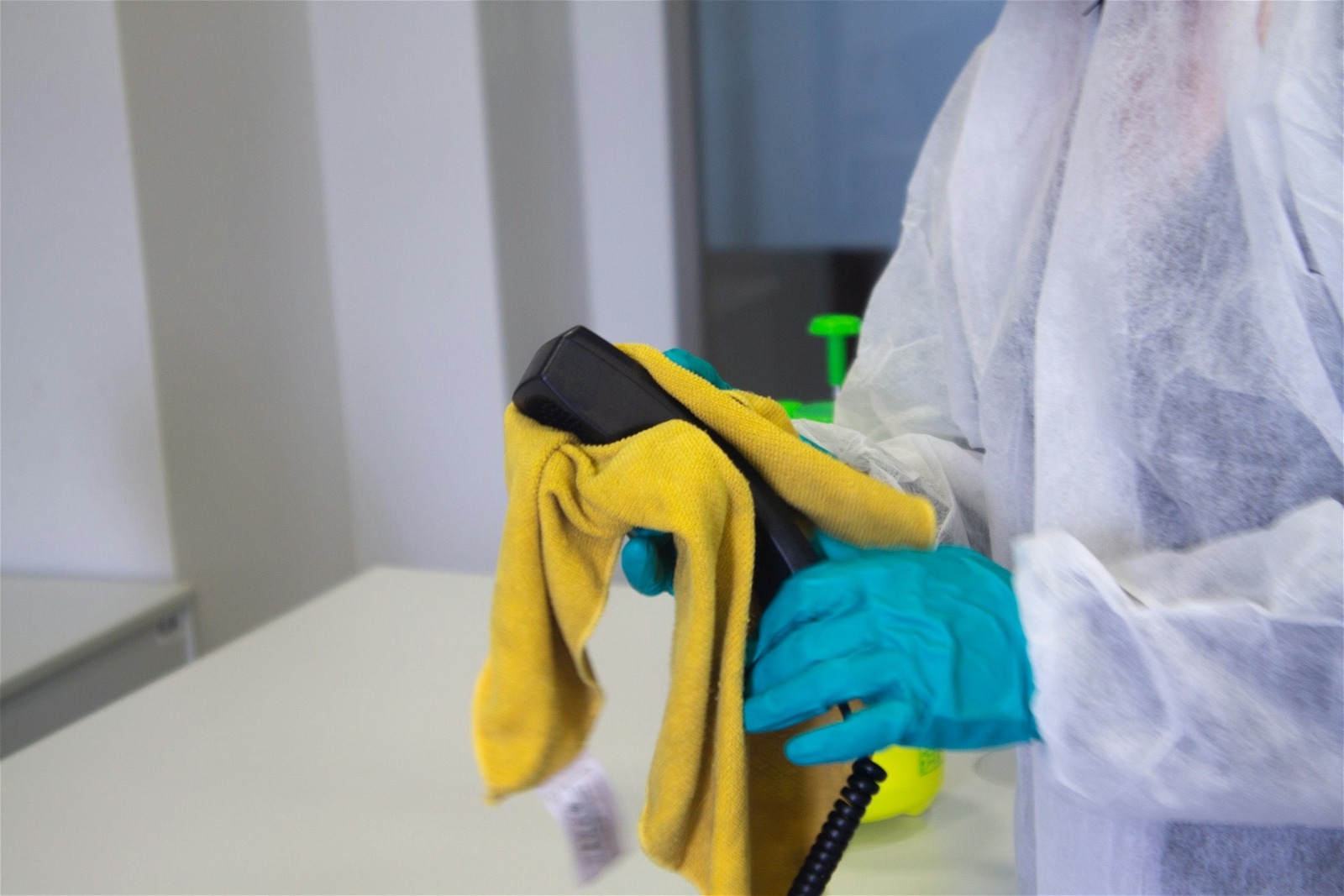 cleaner
cleaner
Picture the most pristine restaurant you’ve ever seen. What makes it so spotless?
The answer lies in three key pillars, the holy trinity of restaurant cleanliness: daily cleaning routines, regular maintenance checks, and the judicious selection and use of cleaning supplies.
Each plays a vital role in maintaining a clean and hygienic environment that tickles the taste buds and keeps customers coming back for more.
Daily Cleaning Routines
The first pillar, daily cleaning routines, is all about consistency. Imagine a restaurant where surfaces are pampered with cleaning and sanitization twice a day or more, depending on their use.
This ensures a clean and safe restaurant space where even the most discerning foodie would feel at ease.
But it’s not just about frequency; it’s also about strategy. The restaurant’s battle against germs involves:
- Using separate utensils for different tasks and giving them a good wash in between
- Cleaning and sanitizing work surfaces and equipment after every use
- Maintaining a hygienic environment that is a stranger to cross-contamination.
Regular Maintenance Checks
Moving on to the second pillar, regular maintenance checks are pivotal.
This is where the restaurant’s superhero squad swoops in to catch and fix any equipment issues before they turn into big messes.
Think of it as a preventive strike against potential hygiene issues that could compromise the safety and satisfaction of the customers.
A vigilant restaurant owner should schedule regular maintenance checks to uncover and address these issues, ensuring the restaurant runs like a well-oiled, spotless machine.
Selection and Use of Cleaning Supplies
The third pillar, the selection and use of cleaning supplies, is the next point of focus.
This is where the art of selecting cleaning supplies for a restaurant comes into play.
From degreasers and sanitizers in the kitchen to disinfectants and odor control products in the bathrooms, each area has its own cleaning needs.
But it doesn’t stop there. To maintain a clean, hygienic, and inviting environment for customers, restaurants need an arsenal of cleaning tools, including a professional cleaning service and:
- Steam cleaners
- Pressure washers
- Dustpans
- Brushes
- Vacuum cleaners
- Cloths
- Rubber gloves
- Sanitizing buckets
- Cleaning wipes
These tools are essential for preventing contamination from raw food and ensuring every corner of the restaurant gleams with cleanliness.
Ensuring Food Safety in Every Bite
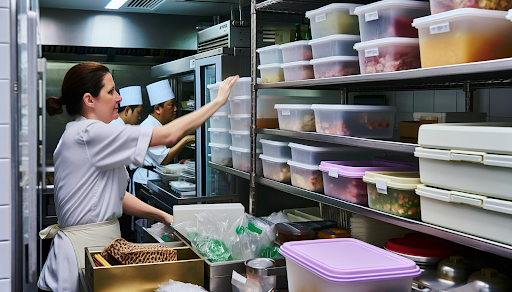 food safety
food safety
Having covered the pillars of restaurant cleanliness, we can now turn our attention to food safety and food quality.
From safe storage techniques to perfect cooking temperatures and preventing cross-contamination, every step in the food preparation process plays a crucial role in ensuring the food served is not only delicious but also safe to eat.
Safe Food Storage Techniques
In the world of food safety, temperature control is akin to a superhero.
It’s the secret weapon against food spoilage and contamination, slowing down bacterial growth in cold temperatures and killing bacteria in hot temperatures.
It’s a delicate balance that requires constant vigilance and proper food safety training.
But it’s not just about temperature. Proper food storage also involves:
- keeping high-risk foods at specific temperatures
- storing dairy products in chilly conditions
- using suitable covered containers for different types of foods
- keeping raw and ready-to-eat foods separated in fridges, freezers, and display units to prevent any unwanted mingling.
Cooking Food to Perfection
Cooking food to perfection is not just about creating mouth-watering dishes but also ensuring they’re safe to consume.
The heat used in cooking plays a starring role in this process, with temperatures of 165°F (74°C) being the magic number that takes down most bacteria.
However, the perfect cooking temperature varies based on the type of food.
For instance, general cooking requires a core temperature of 70°C for 2 minutes, while different meats have their own ideal temperatures.
Maintaining these correct temperatures is crucial for food safety and delivering a dining experience that customers will rave about.
Preventing Cross-Contamination
The final step in ensuring food safety in every bite is preventing cross-contamination, which can lead to food poisoning.
This involves proper food handling practices and the use of separate utensils and surfaces for raw and cooked foods, all aimed at keeping those pesky bacteria at bay while preparing food.
But the battleground isn’t just limited to food items.
The sneaky kitchen surfaces, mischievous utensils, and unclean hands of the cooking staff also play a part in this game of hide and seek with bacteria.
By adopting effective hand washing, sanitizing procedures, and maintaining food hygiene, restaurants can ensure their food remains safe and delicious for all to enjoy.
Personal Hygiene: The First Line of Defense
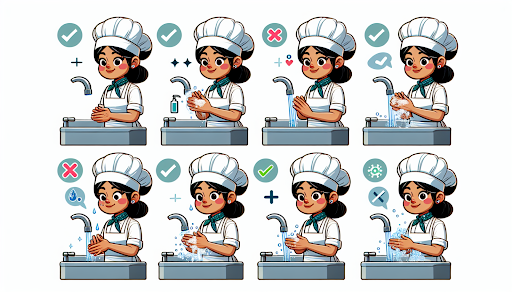 personal hygiene
personal hygiene
Having explored food safety, it’s time to shift our focus to another essential component of restaurant cleanliness: personal hygiene.
A clean restaurant starts with clean staff, making personal hygiene the first line of defense in maintaining a clean and safe restaurant environment.
Importance of Staff Hygiene Training
The cornerstone of personal hygiene in restaurants is comprehensive staff hygiene training.
This ensures employees handle and prepare food in the safest possible manner, shielding customers from any potential health risks.
But why should restaurant staff bother with regular refresher training on hygiene?
Well, it keeps their food safety knowledge sharp and helps them up their game in food safety behavior.
Guidelines for Clean Clothes and Grooming
Cleanliness isn’t just about the restaurant environment; it also extends to the staff’s personal appearance.
This involves following clear guidelines to wear clean clothes and maintain proper grooming.
From sharp shirts and pants to hair and nail hygiene, every detail contributes to the overall cleanliness of the restaurant.
What happens when restaurant staff don’t look their best?
It’s simple – it compromises the overall hygiene of the restaurant, leading to potential food contamination.
So, in order to maintain a high standard of cleanliness, restaurant staff must adhere to strict grooming standards and don clean clothes at all times.
Hand Washing and Sanitizing Procedures
Hand hygiene is a crucial part of personal hygiene in restaurants.
It involves regular hand washing and sanitizing to prevent the spread of germs and contamination.
Restaurant staff should grace their hands with the sanitizing magic at least 2-3 times per hour to keep those pesky germs at bay.
After all, clean hands are the first step towards clean food and a clean restaurant.
Creating a Safe Environment for Customers
It’s time to turn our attention to the customers, the very lifeblood of any restaurant.
From the dining room to the restrooms, every aspect of the restaurant contributes to creating a safe and enjoyable dining experience for customers.
Dining Room Cleanliness
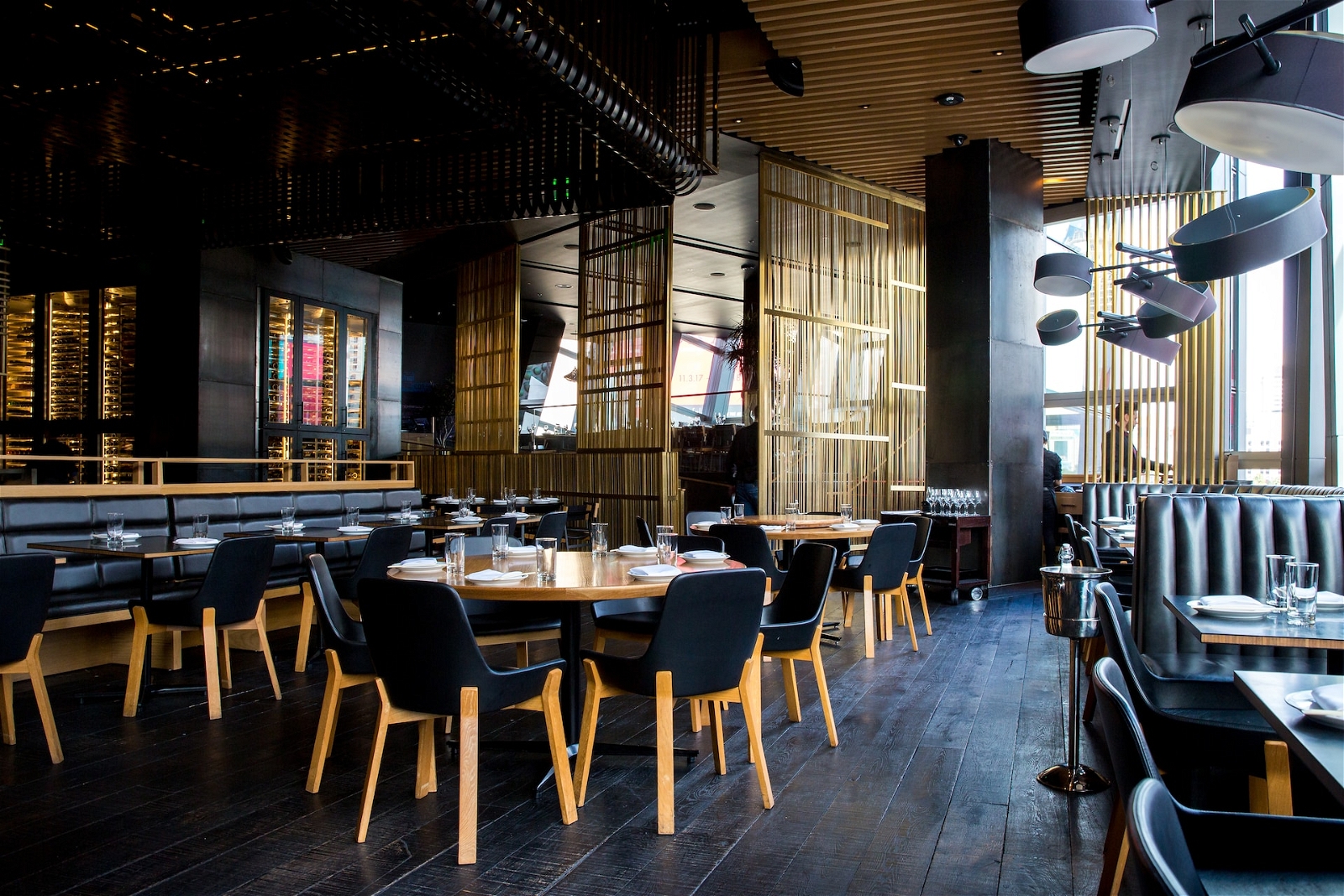 Restaurant
Restaurant
The dining room is the heart of the dirty restaurant, where customers come to relax and enjoy delicious food🥗.
This is why it’s crucial to keep it clean and sanitized, from the tables and chairs to the dining surfaces.
But it’s not just about cleanliness; it’s also about creating a comfortable and safe environment for customers.
A clean dining room translates to a positive dining experience, leading to customer satisfaction and repeat business.
Restroom Upkeep and Hygiene
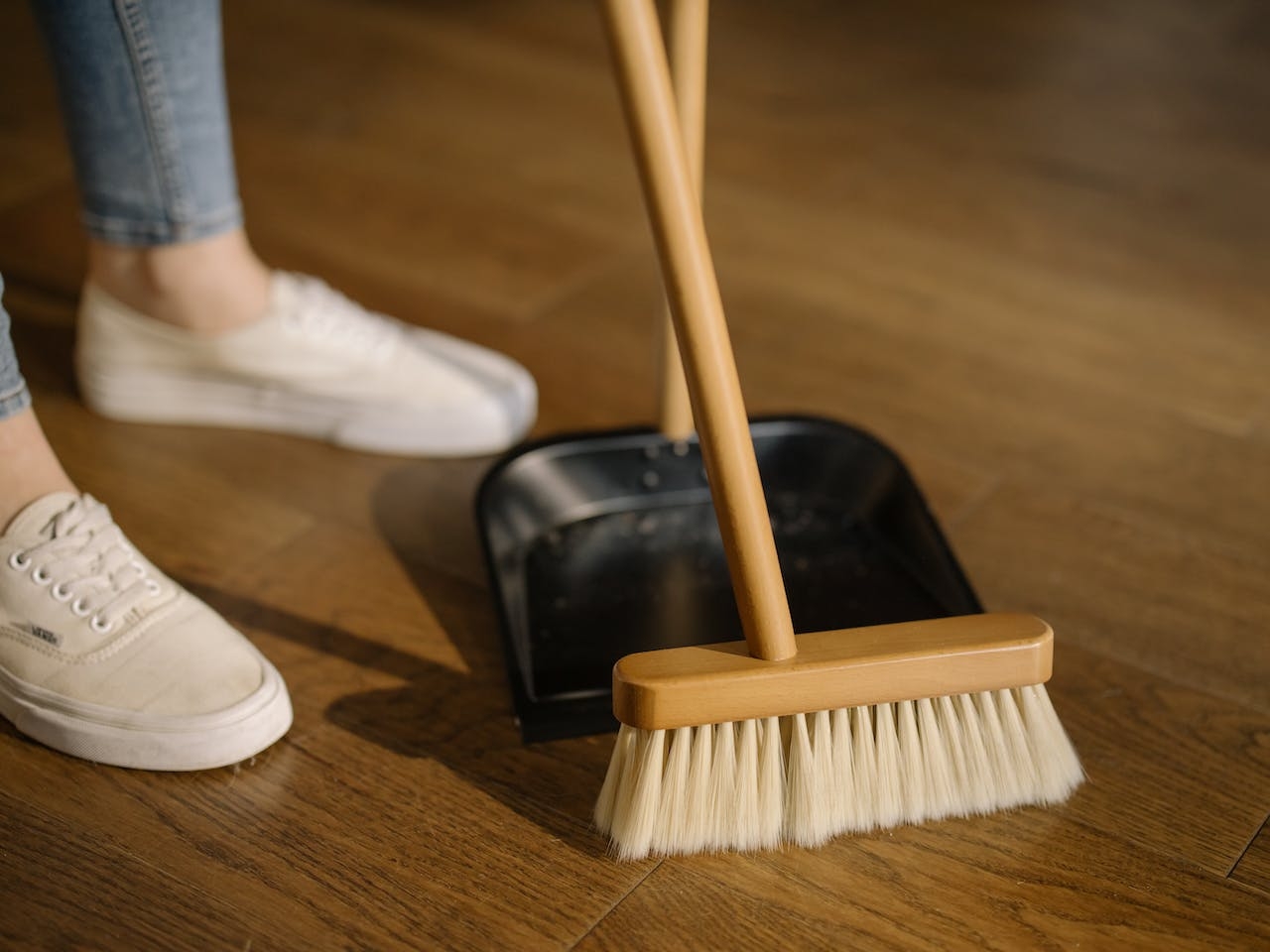 Cleaning
Cleaning
Restrooms are another crucial area in a restaurant that requires proper upkeep and hygiene.
Regular cleaning🧹 and maintenance of restrooms can prevent the spread of germs and maintain a clean and safe environment for customers.
But keeping restrooms clean is more than just about hygiene; it’s also about creating a positive impression on customers.
A spotless restroom not only reflects the restaurant’s commitment to cleanliness but also shows customers that their comfort and well-being are top priorities.
Pest Control Measures
Pest control is another critical aspect of restaurant cleanliness.
Effective pest control measures can prevent infestations and ensure a clean and hygienic restaurant space.
But how often should a restaurant be invaded by pest control experts?
Well, for high-maintenance food stores and healthcare facilities, monthly pest control checks are a must.
But for more laid-back restaurants, quarterly checks should do the trick.
The Business Benefits of a Clean Restaurant
Keeping a clean restaurant transcends hygiene and food safety; it also serves as a shrewd business strategy.
Let’s explore how cleanliness can boost customer trust and loyalty, ensure legal compliance, and enhance a restaurant’s reputation in the industry.
Customer Trust and Loyalty
A clean and hygienic restaurant environment can foster trust and loyalty among customers, leading to:
- Repeat business
- Positive word-of-mouth
- Loyal patrons
- Recommendations to friends and family
Moreover, a spotless restaurant can attract positive reviews from customers, boosting the restaurant’s reputation and drawing in more patrons.
This can lead to increased customer loyalty and a growing fan base.
Legal Compliance and Avoidance of Penalties
Adhering to food safety and hygiene regulations is crucial for any restaurant to avoid legal penalties and maintain a successful business.
Non-compliance can lead to hefty fines, potential jail time, and even the closure of the restaurant.
To avoid these penalties, restaurants must:
- Ensure they comply with all relevant regulations
- Implement a HACCP plan
- Train their staff in food safety
- Monitor food handling processes closely
This way, they can not only avoid legal penalties but also maintain high standards of cleanliness and food safety.
Enhanced Reputation in the Restaurant Industry
Maintaining a clean and hygienic restaurant is a surefire way to boost a restaurant’s reputation in the industry.
Customers often perceive cleanliness as an indicator of the overall quality of the restaurant, affecting their decision to return and recommend the restaurant to others.
Moreover, cleanliness can significantly impact a restaurant’s reputation in the industry.
Restaurants that prioritize cleanliness are often regarded as top-notch dining spots, setting them apart from their competitors.
Summary
In conclusion, cleanliness is the secret sauce in the recipe for a successful restaurant.
From daily cleaning🧹 routines and regular maintenance checks to staff hygiene and safe food handling practices, every aspect of cleanliness plays a crucial role in creating a safe and enjoyable dining experience for customers.
By maintaining a clean and hygienic environment, restaurants can foster customer loyalty, comply with legal regulations, and enhance their reputation in the industry.
So remember, when it comes to running a successful restaurant, cleanliness is not just next to godliness, but the key to success.
Frequently Asked Questions
Why is cleanliness important in food service?
Cleanliness is crucial in food service to prevent food poisoning and ensure that surfaces and equipment remain uncontaminated by harmful bacteria, ultimately keeping customers safe and satisfied with their dining experience.
How do restaurants keep clean?
Restaurants keep clean through regular cleaning schedules and staff training on proper techniques and hygiene.
Why is temperature control important in food safety?
Temperature control is vital in food safety because it slows bacterial growth in cold temperatures and eliminates bacteria in hot temperatures, keeping food safe and preventing spoilage.
How does personal hygiene contribute to restaurant cleanliness?
Personal hygiene sets the tone for restaurant cleanliness. It’s the first step in maintaining a clean and safe environment.
What are the business benefits of maintaining a clean restaurant?
Maintaining a clean restaurant can build customer trust, ensure legal compliance, and boost your reputation in the industry.

